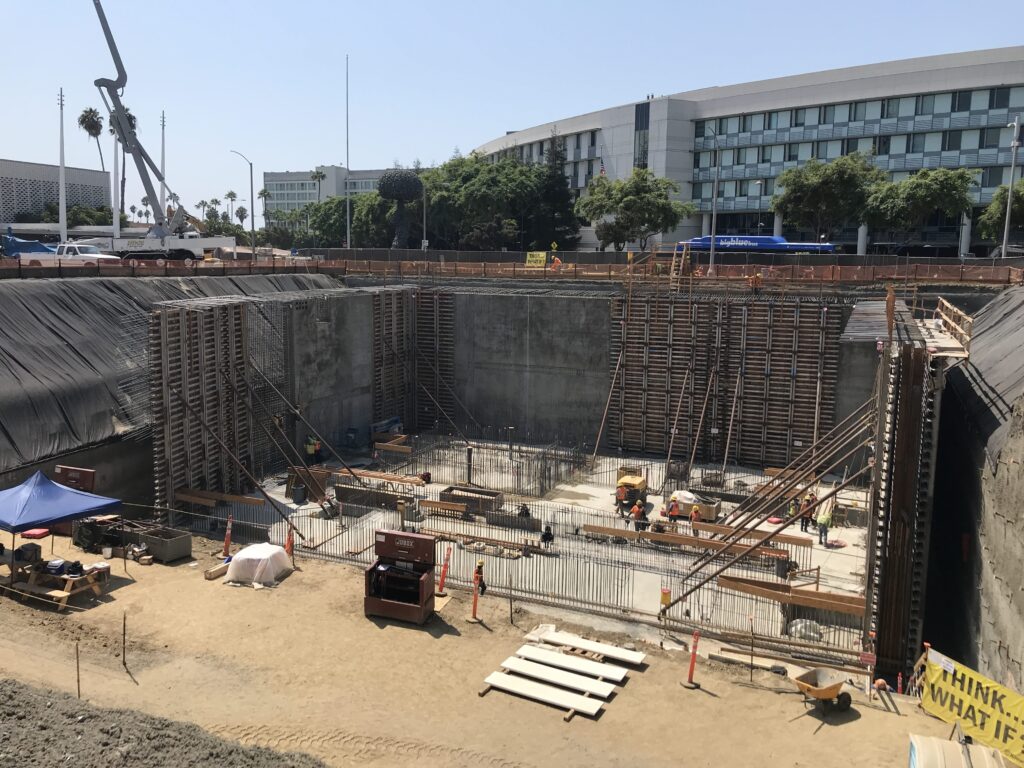(SANTA MONICA, Calif.) – Beneath an ordinary parking lot near Santa Monica City Hall lies a 60-foot deep treatment plant that quietly helps keep the city’s water flowing. On Oct. 15, The Click descended below ground with Water Resources Manager Sunny Wang, shortly after a board meeting about the area’s long-term groundwater strategy.
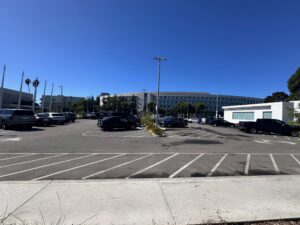
A casual observer would never suspect what lies beneath this unassuming civic parking lot. (Courtesy: Amy Perrette)
With water pipelines often in the Los Angeles headlines — such as a recent Los Angeles Times article on a mountain tunnel carrying Colorado River water south — many assume Santa Monica draws most of its water from other parts of the state. The city actually draws approximately 80% of its water supply from local groundwater and runoff, Wang said.
Runoff water is collected through storm drains carrying everything from car-wash overflow to rainwater. Well-water provides the majority of Santa Monica’s water.
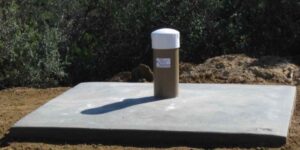
Many Santa Monica wells are hiding-in-plain-sight (courtesy: Sierra Exploration Drilling)
That means wells are dotted throughout the area, hidden in plain sight. Wang says that most people hardly notice the pipe and low platform marking a well, often just in the median of a road.
This subterranean water treatment plant The Click toured can contribute roughly 10% of Santa Monica’s water, purifying reclaimed water.
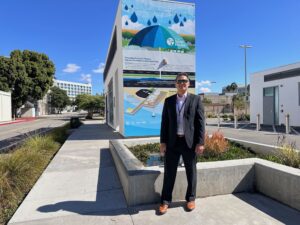
Sunny Wang in front of the entrance to the subterranean facility he helped design and build (courtesy: Amy Perrette)
Wang paused in front of the unmarked door in the Civic Center parking lot before walking down to the machinery below. Only a mural hints at what lies beneath.
The $96 million project opened in 2022 beneath the five-story RAND building, extending almost as deep underground — about the span of six city buses stacked on top of each other, or 60-feet-deep.
Wang said Santa Monica’s self-reliance on local water dates to the early 20th century when the city of Los Angeles leaned on its own aquifer and imported supplies. In contrast, Santa Monica bought three local water companies and has been using mainly local water since 1916.
“We have one of the highest quality drinking waters around,” he said.
Wang wrenched open an interior door, explaining that negative air pressure makes it hard to open. “Being so close to City Hall, the courthouse, and a school, odor was a big concern,” he said. Inside the room, however, the smell was faint — all the air is replaced seven times an hour.

Runoff water ready to be purified (Courtesy: Amy Perrette)
The collected water starts its treatment journey with a rotary screen that strips out larger debris before the flow enters a membrane bioreactor, where microbes and filtration work in tandem to break down organics. From there, ultrafiltration screens out viruses and pathogens, followed by cartridge filters that polish the water.
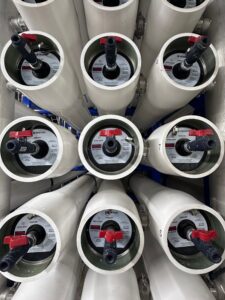
Reverse Osmosis is the core of the purification process (Courtesy: Amy Perrette)
Reverse osmosis — the workhorse — removes dissolved contaminants and other molecules. An ultraviolet light process follows in order to destroy pharmaceutical compounds. Finally, the water is disinfected to finish the purification.
The subterranean water treatment plant and other purification facilities have to work hard — industrial contamination is a challenge for urban communities. Santa Monica’s Charnock Well Field was polluted by gasoline additives in the mid-1990s and industrial solvents entered the Olympic Well Field ten years earlier.
Thanks to multi-barrier treatment systems, those contaminants do not reach residents’ taps.

Sunny Wang enjoys a drink of purified water from a small faucet. (Courtesy: Amy Perrette)
“This is one of the highest quality waters that you see around,” Wang said, cupping his hands to take a drink from a tap at the end of the line. The Click also tasted the water — ordinary without a hint of its journey.
“We’re essentially doing what Mother Nature does, using technology,” Wang said.
That logic underpins the city’s drought resilience by capturing local runoff before it hits the bay, treat it, and lean on wells. The California government mandates that the Santa Monica Basin Groundwater Sustainability Agency keep the groundwater system sustainable.
Hydrogeologist Jill Weinberger, a consultant hired by the agency who presented at the Oct. 15 board meeting, underscored the importance of managing the wells’ sustainability.
“They provide a buffer in [drought] years when surface water [from reservoirs and the Sierra snowpack] is not available,” she said.

Dr. Margot Griswold at Crystal Cove State Park inspecting restoration sites (Courtesy: Margot Griswold)
Community member Dr. Margot Griswold, a restoration ecologist, attended the meeting through Zoom. She urged the board not to lose sight of ecosystems.
“We are speaking for nature — and for the [Ballona] wetlands,” she told The Click after the meeting. She said a tide-control gate is in disrepair and is failing to block ocean-water intrusion into a formerly freshwater area.
The board is moving forward with a monitoring well to assess for saltwater intrusion, though the placement is still being decided.
